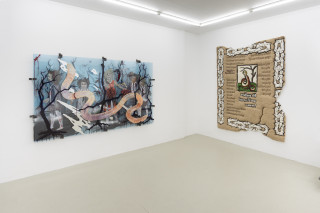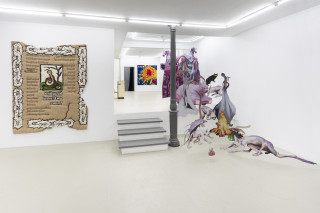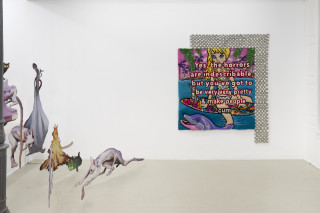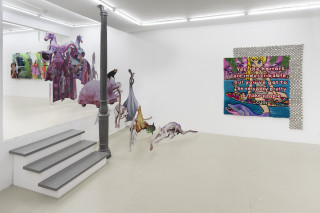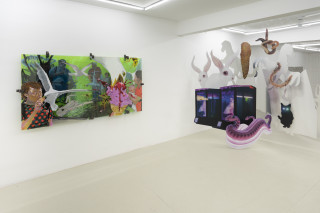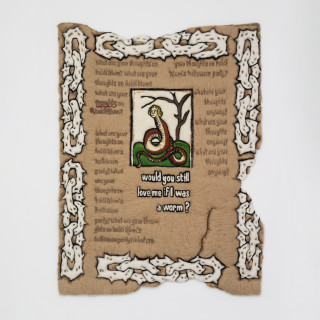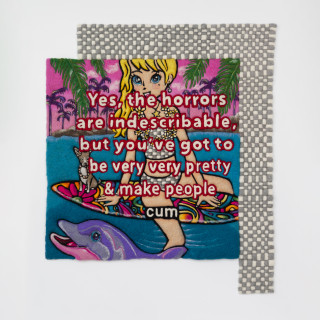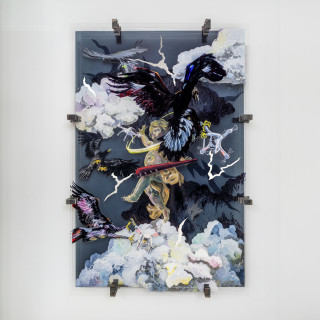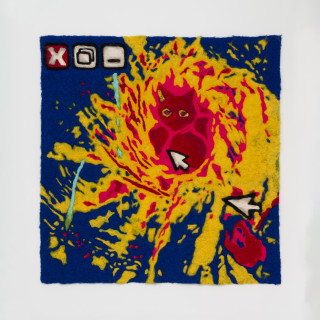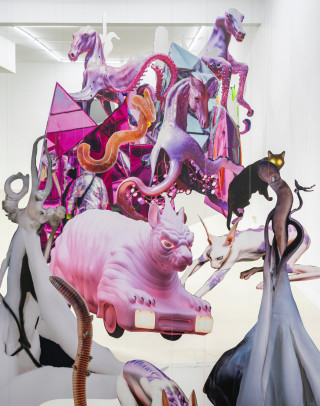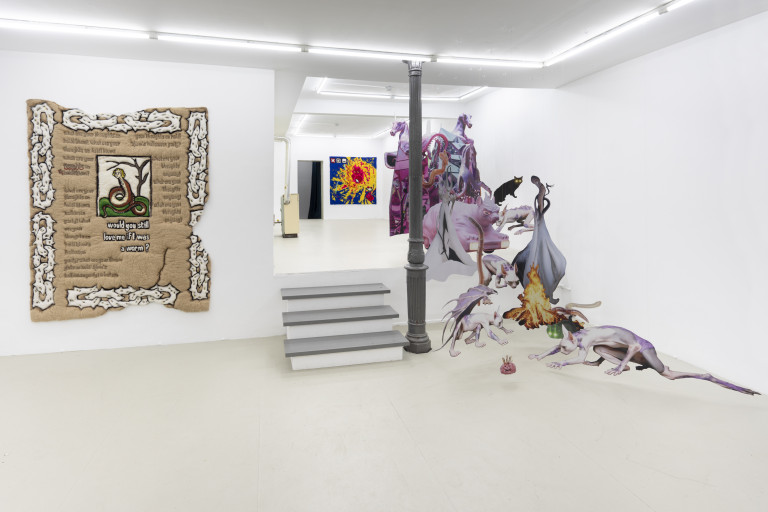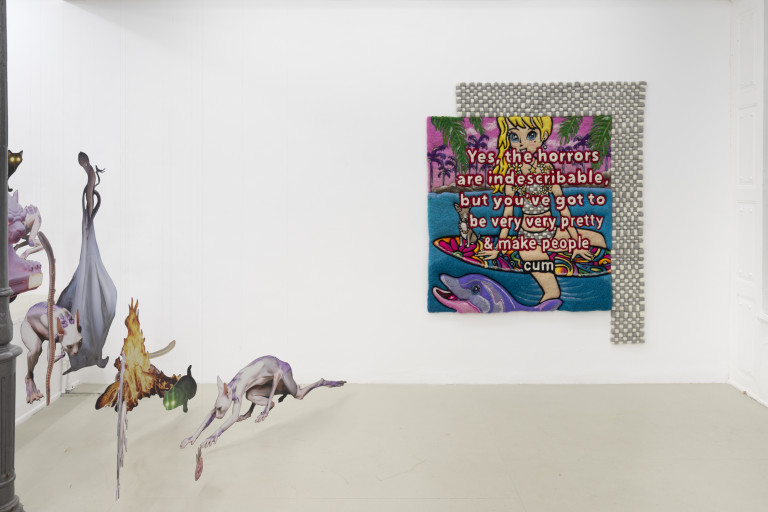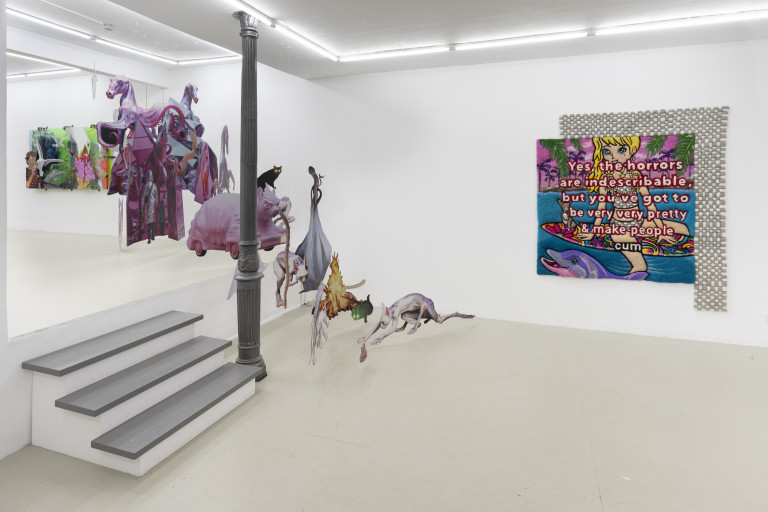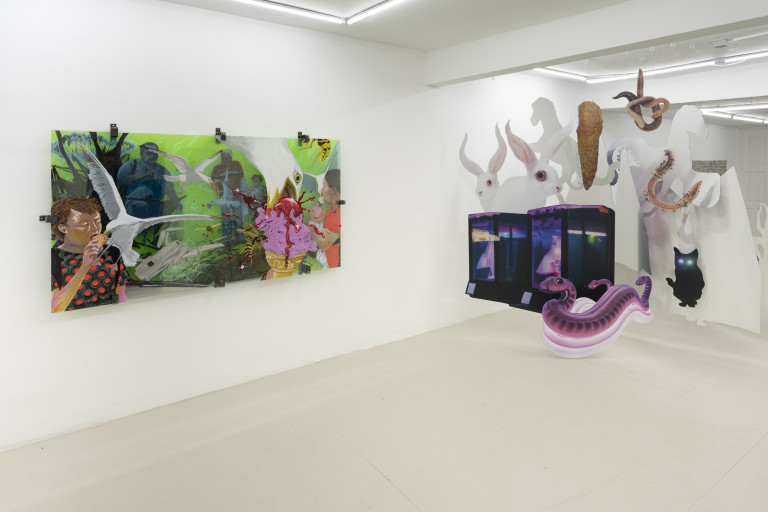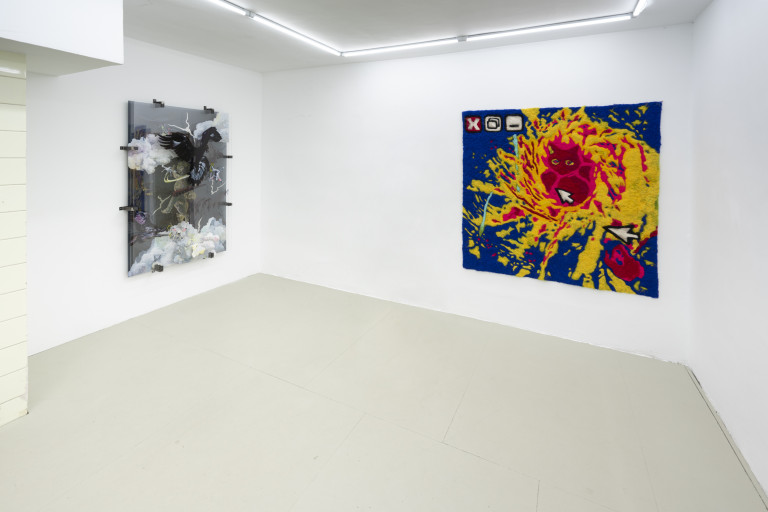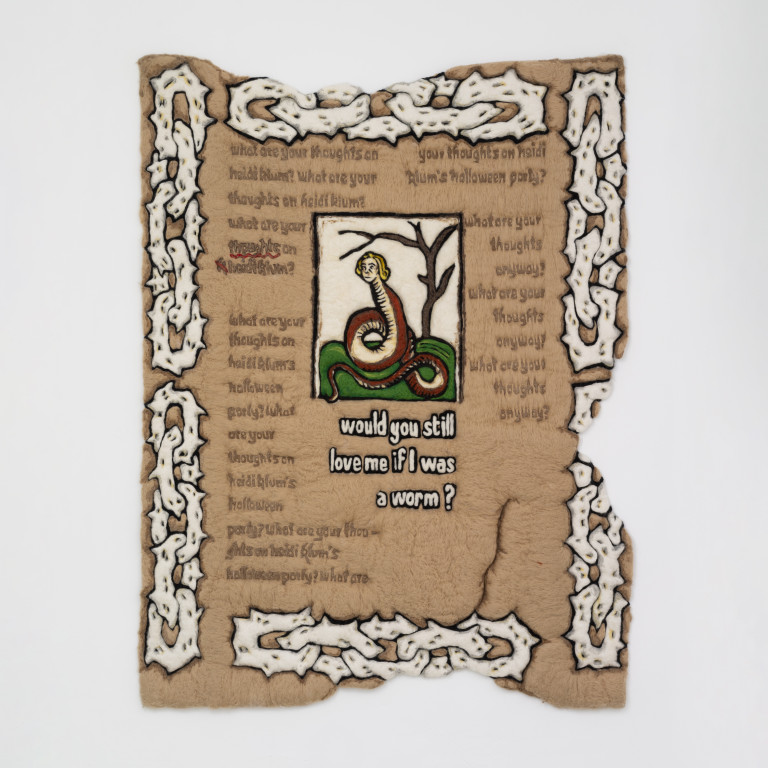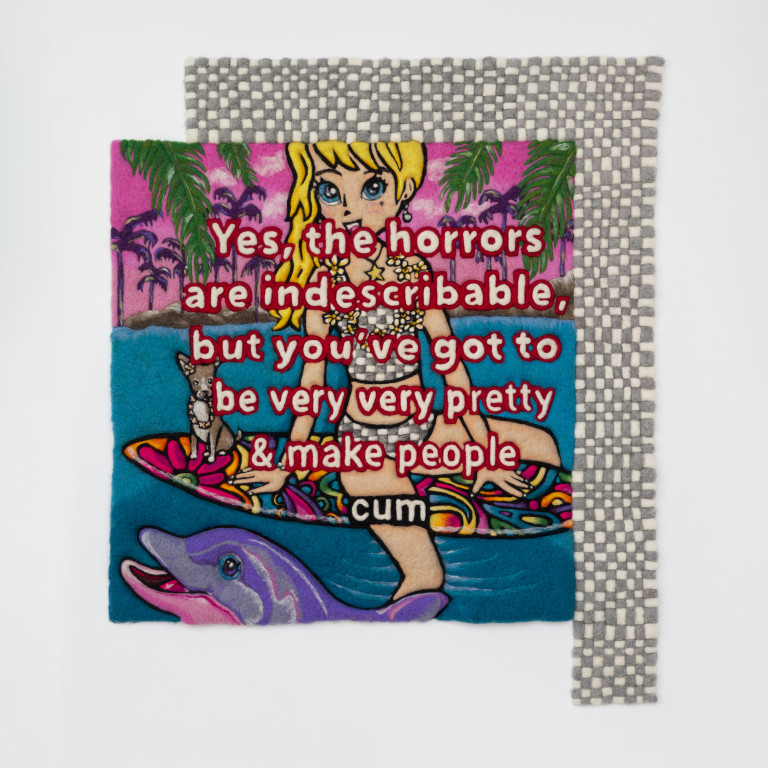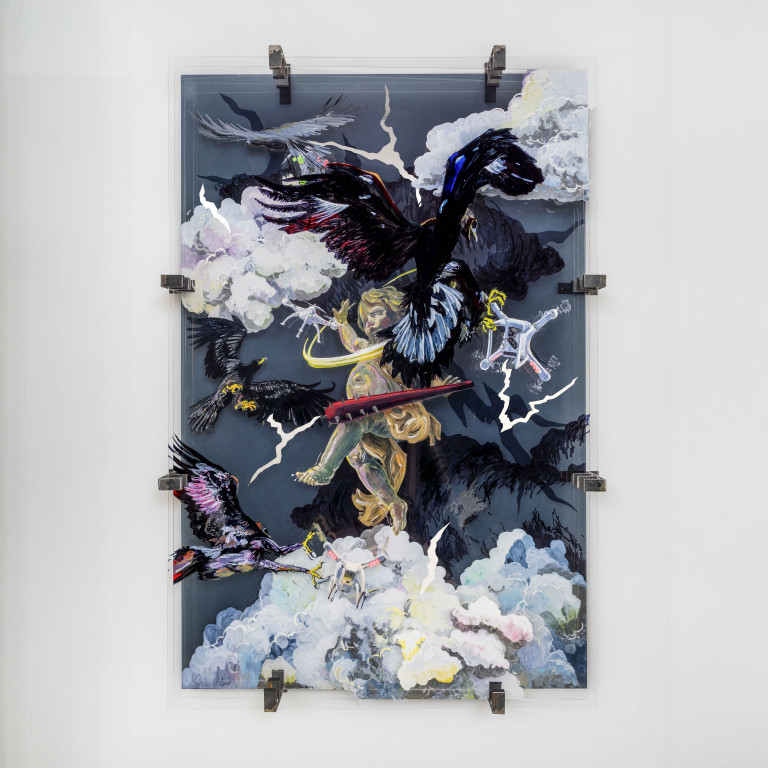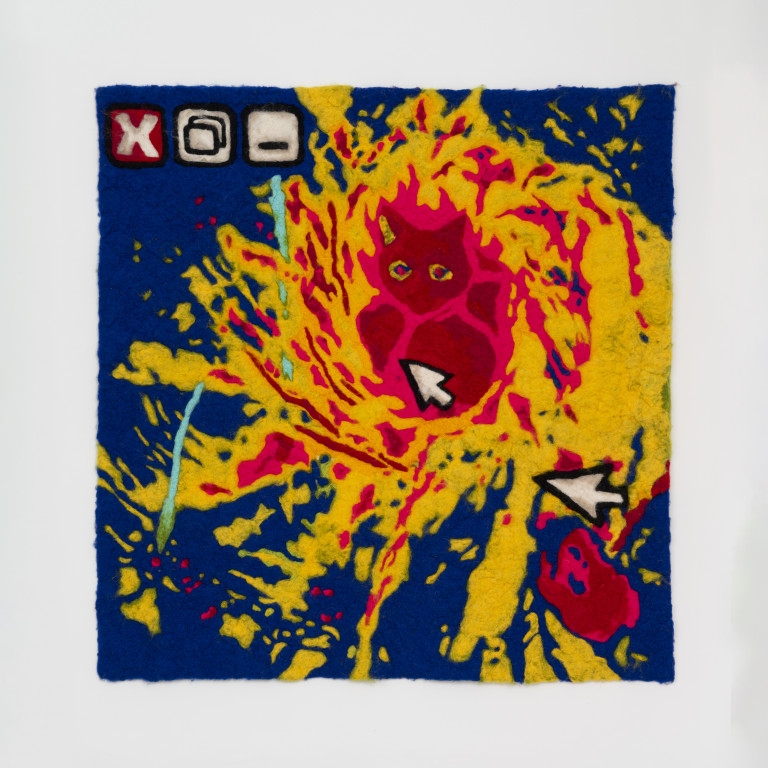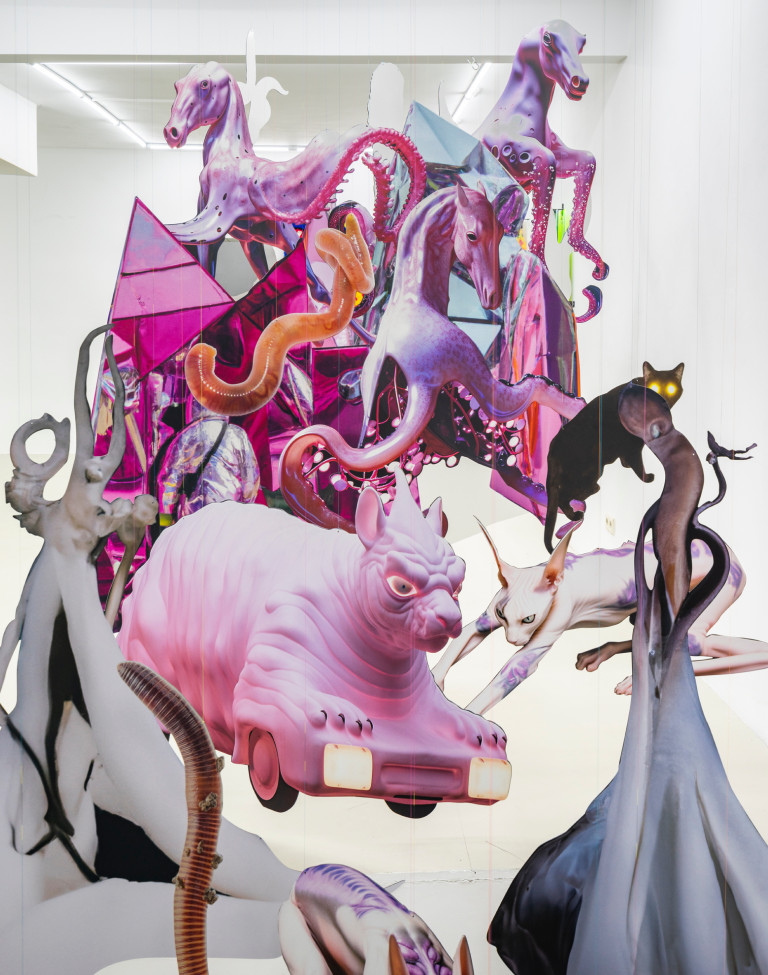Would you still love me if I was a worm?
Iris Helena Hamers / Lucia Mattes
Dec 2nd - Jan 5th, 2024
Opening / Dec 1st, 7PM
The exhibition „Would you still love me if I was a worm“ brings together two artists, Iris Helena Hamers and Lucia Mattes, who deal with images and forms of expression on the internet and translate them into multi-layered works. The starting point for both positions is often the digital object - an image, a meme, a video, which finds a new, sometimes surprising materiality in the works.
Lucia Mattes creates her works with felt, thus contrasting the fast pace of net culture with a lengthy manual process. In her work „Would you stilllove me if I was a worm?“ (2023), she spans a wide temporal arc and merges various motifs that are as disparate as possible. The illustration is taken from a medieval herb book and shows a so-called draconcopedes, a snake-like creature with a female head. However, the eye trained less on medieval zoological depictions and more on current popular and everyday culture immediately recognizes Heidi Klum in her Halloween party worm costume from 2022. Both the Heidi Klum worm photos and her question on Instagram „Would you still love me if I was a worm?“ have been taken up and developed further in numerous memes and are examples of the life of their own that virtual phenomena often develop at breakneck speed. In Mattes‘ felt work, the central image is framed by several blocks of text that invite a dialog: „what are your thoughts on heidi klum?“
The work „To Nihilisa Frank“ (2023) refers to a „veteran of meme culture“, as Mattes puts it. The Tumblr Nihilisa Frank emerged in 2015 and took up the pop imagery of the Lisa Frank Inc. universe: brightly colored little animals - unicorns, pandas, dolphins - that were mainly found in US children‘s rooms in the 1990s. Nihilisa Frank added nihilistic quotes to themand turned the sugar-sweet childhood memories into bearers of statements that were not very cheerful. Mattes takes up the genesis of these image-text combinations, adds her own layers of content and invites us to think about the work further by replacing the last word „cum“ with our own punchlines.
Iris Helena Hamer‘s artistic practice revolves around questioning the medium of painting: in several groups of works, she explores its limits and possibilities and creates complex, dream-like pictorial worlds that are anchored in the artist‘s subjective experience but open up to the associations of the viewer. Here, too, we encounter the (Klumian) worm: In „Heidi“ (2022), he meanders headlessly across the entire picture surface, while zombie girls stalk towards the viewer in the background. While the depth of the pictorial space in classical painting is created by painterly means, in this work three differently painted acrylic glass panes are mounted one behind the other, creating a front and back. They are held together and at the same time separated from each other by large steel clamps, thus revealing the construction of the work. Similar to Mattes, Hamers also refers in her work to fragments of popular cultural knowledge that we acquire on our forays through the Internet. Once again, the viewer is invited to think further about the narrative suggested by the set pieces and - if they wish - to place Heidi, the worm and the zombie girls in their own context.
In the installation „My strange harvest will taste sweet again“ (2023), Hamers places AI-generated motifs in a dialog with self-generated representations: She manipulates digital found footage in digital painting, feeding her own images into AI programs so that they become the starting point for artificially intelligent further development. The result makes it impossible to distinguish between human and machine-created images. The resulting motifs are printed onto cut aluminum plates using UV printing and finally join together in space to form their final composition. Hamers thus transforms the digital works into actual objects and enables us to interact with them in a new, more direct, more physical way. She creates a wild dream world whose surfaces appear sometimes slippery, sometimes velvety, sometimes metallic. In it, the viewer searches for a context, for a narrative that connects the individual fragments. And which, as in„real“ digital life, often does not exist.
Text: Ferial Nadja Karrasch
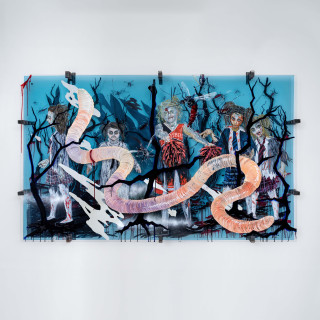
Iris Helena Hamers
Heidi, 2022
acrylic and ink markers, graphite, spy film and spray paint on acrylic glass, steel
140 x 235 x 13 cm
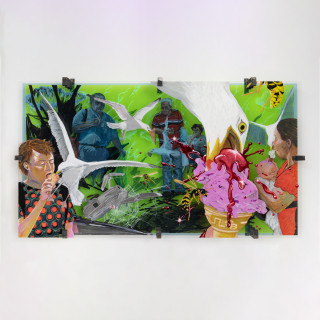
Iris Helena Hamers
Grand Theft, 2023
acrylic and ink markers, graphite and spy film on acrylic glass, steel
100 x 180 x 13 cm
Would you still love me if I was a worm?
Iris Helena Hamers / Lucia Mattes
Dec 2nd - Jan 5th, 2024
Opening / Dec 1st, 7PM
The exhibition „Would you still love me if I was a worm“ brings together two artists, Iris Helena Hamers and Lucia Mattes, who deal with images and forms of expression on the internet and translate them into multi-layered works. The starting point for both positions is often the digital object - an image, a meme, a video, which finds a new, sometimes surprising materiality in the works.
Lucia Mattes creates her works with felt, thus contrasting the fast pace of net culture with a lengthy manual process. In her work „Would you stilllove me if I was a worm?“ (2023), she spans a wide temporal arc and merges various motifs that are as disparate as possible. The illustration is taken from a medieval herb book and shows a so-called draconcopedes, a snake-like creature with a female head. However, the eye trained less on medieval zoological depictions and more on current popular and everyday culture immediately recognizes Heidi Klum in her Halloween party worm costume from 2022. Both the Heidi Klum worm photos and her question on Instagram „Would you still love me if I was a worm?“ have been taken up and developed further in numerous memes and are examples of the life of their own that virtual phenomena often develop at breakneck speed. In Mattes‘ felt work, the central image is framed by several blocks of text that invite a dialog: „what are your thoughts on heidi klum?“
The work „To Nihilisa Frank“ (2023) refers to a „veteran of meme culture“, as Mattes puts it. The Tumblr Nihilisa Frank emerged in 2015 and took up the pop imagery of the Lisa Frank Inc. universe: brightly colored little animals - unicorns, pandas, dolphins - that were mainly found in US children‘s rooms in the 1990s. Nihilisa Frank added nihilistic quotes to themand turned the sugar-sweet childhood memories into bearers of statements that were not very cheerful. Mattes takes up the genesis of these image-text combinations, adds her own layers of content and invites us to think about the work further by replacing the last word „cum“ with our own punchlines.
Iris Helena Hamer‘s artistic practice revolves around questioning the medium of painting: in several groups of works, she explores its limits and possibilities and creates complex, dream-like pictorial worlds that are anchored in the artist‘s subjective experience but open up to the associations of the viewer. Here, too, we encounter the (Klumian) worm: In „Heidi“ (2022), he meanders headlessly across the entire picture surface, while zombie girls stalk towards the viewer in the background. While the depth of the pictorial space in classical painting is created by painterly means, in this work three differently painted acrylic glass panes are mounted one behind the other, creating a front and back. They are held together and at the same time separated from each other by large steel clamps, thus revealing the construction of the work. Similar to Mattes, Hamers also refers in her work to fragments of popular cultural knowledge that we acquire on our forays through the Internet. Once again, the viewer is invited to think further about the narrative suggested by the set pieces and - if they wish - to place Heidi, the worm and the zombie girls in their own context.
In the installation „My strange harvest will taste sweet again“ (2023), Hamers places AI-generated motifs in a dialog with self-generated representations: She manipulates digital found footage in digital painting, feeding her own images into AI programs so that they become the starting point for artificially intelligent further development. The result makes it impossible to distinguish between human and machine-created images. The resulting motifs are printed onto cut aluminum plates using UV printing and finally join together in space to form their final composition. Hamers thus transforms the digital works into actual objects and enables us to interact with them in a new, more direct, more physical way. She creates a wild dream world whose surfaces appear sometimes slippery, sometimes velvety, sometimes metallic. In it, the viewer searches for a context, for a narrative that connects the individual fragments. And which, as in„real“ digital life, often does not exist.
Text: Ferial Nadja Karrasch
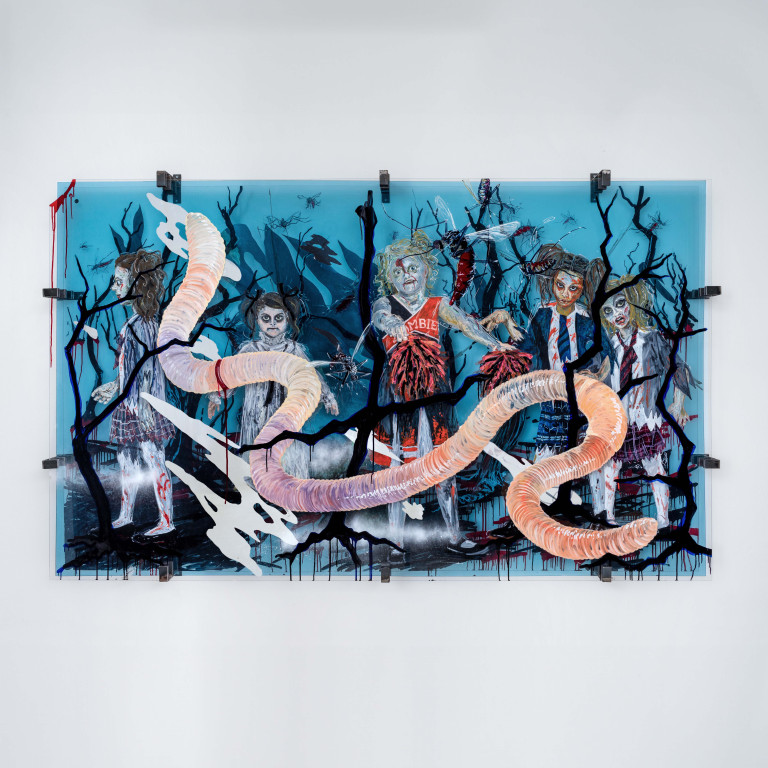
Iris Helena Hamers
Heidi, 2022
acrylic and ink markers, graphite, spy film and spray paint on acrylic glass, steel
140 x 235 x 13 cm
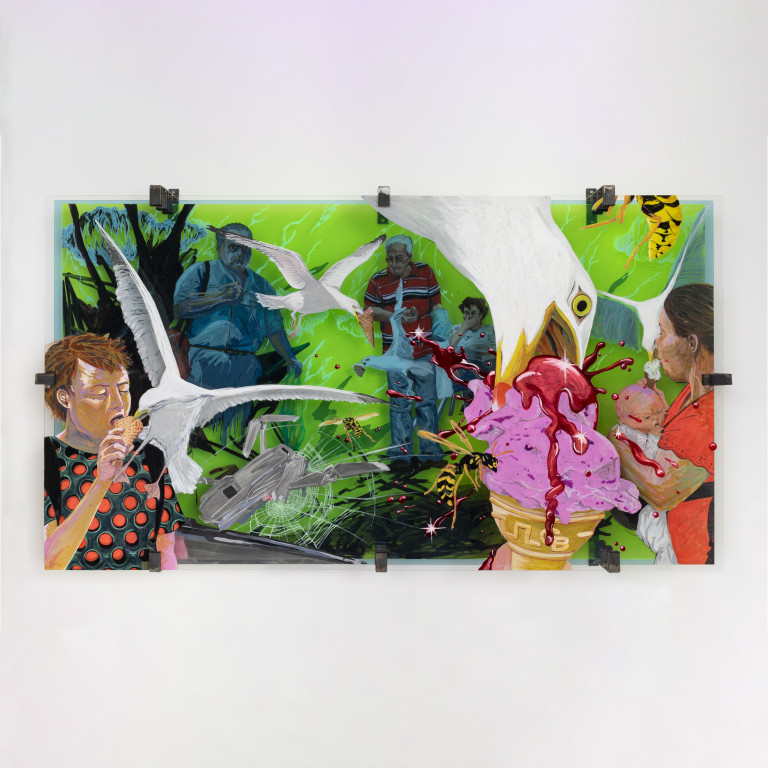
Iris Helena Hamers
Grand Theft, 2023
acrylic and ink markers, graphite and spy film on acrylic glass, steel
100 x 180 x 13 cm
